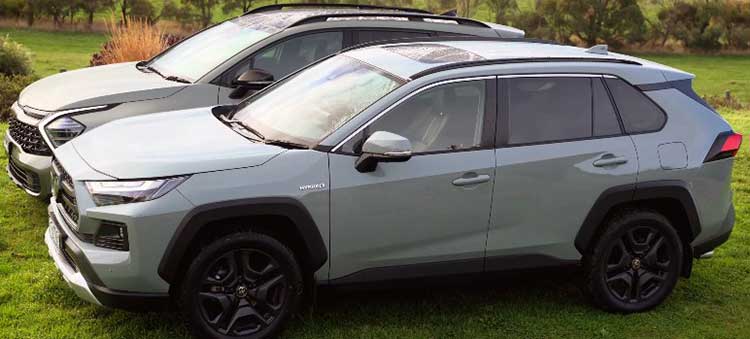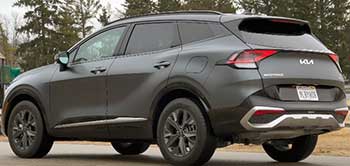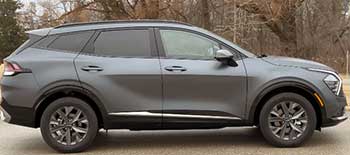I’ve always been drawn to hybrid SUVs for their blend of efficiency and practicality. When it came time to choose my next ride, the Kia Sportage Hybrid and Toyota RAV4 Hybrid topped my list. Both are leaders in the compact hybrid SUV market, offering fuel-sipping performance and family-friendly features. In this article, I’ll share my first-hand insights, weighing the pros and cons of each to help you decide which suits your lifestyle best. From powertrains to interiors, I’ll break it all down in a way that’s clear, engaging, and honest.

Comparison Table of Kia Sportage Hybrid vs Toyota RAV4 Hybrid
| Feature | Kia Sportage Hybrid (2025) | Toyota RAV4 Hybrid (2025) |
| Starting MSRP | $30,185 | $31,900 |
| Engine | 1.6L Turbo 4-cylinder + electric motor | 2.5L 4-cylinder + electric motors |
| Horsepower | 227 hp | 219 hp |
| Torque | 258 lb-ft | 163 lb-ft |
| Transmission | 6-speed automatic | eCVT |
| Drivetrain | FWD standard, AWD optional | AWD standard |
| Fuel Economy (MPG) | 42/44 (FWD), 38/38 (AWD) | 41/38 (AWD) |
| Cargo Space | 39.5 cu ft (seats up), 73.7 cu ft (seats down) | 37.5 cu ft (seats up), 69.8 cu ft (seats down) |
| Warranty | 5-yr/60,000-mile basic, 10-yr/100,000-mile powertrain | 3-yr/36,000-mile basic, 5-yr/60,000-mile powertrain |
| Infotainment | 8-inch (base) or dual 12.3-inch screens | 8-inch or 10.5-inch touchscreen |
| Safety Rating (NHTSA) | 5 stars (frontal crash) | 5 stars (overall) |
| Key Features | Dual-screen display, Kia Connect app, panoramic sunroof | Toyota Safety Sense 2.5+, free maintenance (2 yrs/25,000 miles) |
My Journey with Hybrid SUVs
The compact hybrid SUV segment has exploded in recent years, and for good reason. These vehicles marry the practicality of an SUV with the efficiency of a hybrid, making them ideal for folks like me who want to save on gas without sacrificing space or versatility. I’ve spent countless hours test-driving, researching, and living with SUVs, and the Kia Sportage Hybrid and Toyota RAV4 Hybrid stand out as two of the best.
They’re not just cars—they’re lifestyle enablers, whether you’re hauling kids, gear, or just cruising to work. My goal here is to share what I’ve learned from my time behind the wheel, comparing these two heavyweights to help you make an informed choice.
Kia Sportage Hybrid Overview
When I first slid into the 2025 Kia Sportage Hybrid, I was struck by its bold, futuristic vibe. The exterior, with its boomerang-style LED daytime running lights and sleek grille, feels like it’s from a sci-fi movie. Inside, the cabin is a tech lover’s dream, especially in higher trims like the SX Prestige, where dual 12.3-inch screens create a seamless digital dashboard.

The hybrid powertrain—a 1.6-liter turbocharged engine paired with an electric motor—delivers 227 horsepower and 258 pound-feet of torque.
It’s paired with a six-speed automatic transmission, offering a smooth, traditional driving feel. I found the Sportage Hybrid punchy, especially in city traffic, with a 0-60 mph time of about 6.9 seconds.
The Sportage Hybrid’s fuel economy is impressive, hitting 42 MPG combined with front-wheel drive, though it drops slightly with AWD. Cargo space is a highlight, offering 39.5 cubic feet behind the rear seats and up to 73.7 cubic feet with them folded. I found this perfect for weekend getaways or grocery runs.
The Kia Connect app, which lets me control climate settings or lock the car remotely, felt like a small but delightful luxury. Plus, that 10-year/100,000-mile powertrain warranty gave me peace of mind, especially for a hybrid with complex components.
Pros of the Kia Sportage Hybrid
- Bold Design: The futuristic styling turns heads, and the interior feels modern and upscale.
- Powerful Performance: 227 hp and 258 lb-ft of torque make it quick and engaging.
- Spacious Cargo: 73.7 cubic feet of cargo space beats most competitors.
- Long Warranty: 10-year/100,000-mile powertrain coverage is unmatched.
- Tech-Savvy: Dual 12.3-inch screens and Kia Connect app elevate the experience.
Cons of the Kia Sportage Hybrid
- AWD Costs Extra: Unlike the RAV4, AWD isn’t standard and adds about $1,800.
- Complex Controls: The switchable touch panel can be confusing at first.
- Resale Value: Loses an estimated 37.1% of value over 5 years.
Toyota RAV4 Hybrid Overview
The 2025 Toyota RAV4 Hybrid, on the other hand, is the dependable workhorse of the segment. Its boxy, rugged design isn’t as flashy as the Sportage, but it exudes a timeless reliability that’s hard to ignore. Under the hood, a 2.5-liter four-cylinder engine teams up with dual electric motors for 219 horsepower and 163 pound-feet of torque. It’s not as punchy as the Sportage, but it’s smooth and predictable, with a combined 39 MPG (updated to 2025 estimated EPA figures) that’s only a hair behind its rival.

Inside, the RAV4 feels functional but dated. The 8-inch touchscreen (10.5 inches on higher trims) gets the job done, but it lacks the wow factor of Kia’s setup.
Cargo space is slightly less generous at 37.5 cubic feet behind the seats and 69.8 cubic feet total, but I still found it ample for most needs.
Toyota’s edge comes from its standard AWD and Toyota Safety Sense 2.5+, which includes adaptive cruise control and lane-keeping assist. The two years of free maintenance (up to 25,000 miles) was a nice perk, saving me some cash early on.
Pros of the Toyota RAV4 Hybrid
- Proven Reliability: Toyota’s track record and an estimated 8.0/10 reliability rating (based on CarEdge data for 2025) inspire confidence.
- Standard AWD: All trims include AWD, great for all-weather driving.
- Free Maintenance: Two years or 25,000 miles of covered service saves money.
- Fuel Efficiency: 39 MPG combined is nearly as good as the Sportage.
- Safety Suite: Toyota Safety Sense 2.5+ is robust and user-friendly.
Cons of the Toyota RAV4 Hybrid
- Higher Starting Price: $31,900 vs. Sportage’s $30,185.
- Dated Interior: The cabin feels old compared to the Sportage’s modern design.
- Less Power: 219 hp is adequate but lacks the Sportage’s zip.
- Smaller Cargo: 69.8 cubic feet is less than the Sportage’s maximum.
Performance Comparison
Driving the Sportage Hybrid felt like a revelation. Its turbocharged engine gives it a slight edge in acceleration, hitting 0-60 mph in about 6.9 seconds. The six-speed automatic transmission shifts smoothly, avoiding the rubbery feel of some eCVTs. I noticed it was particularly lively in Sport mode, making it fun for zipping through traffic or tackling winding roads.
The RAV4 Hybrid, by contrast, takes a more laid-back approach. Its eCVT and 2.5-liter engine deliver power steadily but without the same urgency, with a 0-60 time closer to 7.8 seconds. It’s not slow, but it prioritizes efficiency over excitement. I appreciated the standard AWD, which gave me confidence on wet roads, but the Sportage’s optional AWD felt just as capable when I tested it. If you’re after a spirited drive, the Sportage has the edge; if you want a smoother, more predictable ride, the RAV4 delivers.
Interior and Comfort
Stepping into the Sportage’s cabin was like entering a tech showroom. The dual-screen setup (standard on EX and above) is crisp and intuitive, blending the instrument cluster and infotainment seamlessly. The materials, while not quite luxury-grade, look upscale, and features like heated and ventilated seats or a panoramic sunroof (on SX Prestige) made long drives a treat. Rear legroom is class-leading at 41.3 inches, and my passengers never complained about feeling cramped.
The RAV4’s interior, while practical, felt like it was stuck in 2019. The cloth seats (upgradable to SofTex) are comfortable but plain, and the dashboard design is utilitarian. Rear legroom is slightly less at 37.8 inches, which I noticed when taller friends rode along. However, the RAV4’s cabin is quiet, and the optional 10.5-inch touchscreen is responsive, though it doesn’t match the Sportage’s flair. If tech and style matter to you, the Sportage wins; if you prefer simplicity and durability, the RAV4 holds its own.
Also Read: Kia Sportage vs. Subaru Crosstrek
Technology and Features
The Sportage Hybrid’s tech suite blew me away. The Kia Connect app let me pre-cool the cabin on hot days, and the available Harman Kardon audio system was a joy for my playlists. Higher trims offer Highway Driving Assist, which combines adaptive cruise control and lane-keeping for semi-autonomous driving. The switchable touch panel for climate and audio controls took some getting used to, but it’s a minor quirk in an otherwise stellar setup.
The RAV4 Hybrid counters with Toyota Safety Sense 2.5+, which I found reliable for keeping me centered in lanes and maintaining safe distances in traffic. The infotainment supports wireless Apple CarPlay and Android Auto, but the base 8-inch screen feels small compared to Kia’s. Toyota’s free maintenance plan is a practical bonus, and the availability of more dealerships (over 1,200 Toyota dealerships vs. ~800 Kia dealerships in the US) means service is easier to access. For cutting-edge tech, the Sportage leads; for proven safety and serviceability, the RAV4 shines.
Safety and Reliability
Both SUVs score high on safety. The Sportage Hybrid earned a 5-star frontal crash rating from the NHTSA and a 2024 IIHS Top Safety Pick for its performance in crash tests and pedestrian detection. Features like Safe Exit Warning and Driver Attention Warning add extra layers of protection, which I appreciated in busy parking lots.
The RAV4 Hybrid also boasts a 5-star NHTSA overall rating and includes a post-collision braking system, a feature the Sportage lacks. Toyota’s reputation for reliability is legendary, with Consumer Reports ranking it high, though the RAV4 Hybrid’s reliability score (an estimated 8.0/10 by CarEdge for 2025 models) is comparable to the Sportage’s (an estimated 8.1/10). Kia’s longer warranty (10 years/100,000 miles powertrain vs. Toyota’s 5 years/60,000 miles powertrain) tipped the scales for me, as it covers the hybrid powertrain’s complexities well into the future.
Pros and Cons of Kia Sportage Hybrid
- Bold Design: The futuristic styling turns heads, and the interior feels modern and upscale.
- Powerful Performance: 227 hp and 258 lb-ft of torque make it quick and engaging.
- Spacious Cargo: 73.7 cubic feet of cargo space beats most competitors.
- Long Warranty: 10-year/100,000-mile powertrain coverage is unmatched.
- Tech-Savvy: Dual 12.3-inch screens and Kia Connect app elevate the experience.
Cons of Kia Sportage Hybrid
- AWD Costs Extra: Unlike the RAV4, AWD isn’t standard and adds about $1,800.
- Complex Controls: The switchable touch panel can be confusing at first.
- Resale Value: Loses an estimated 37.1% of value over 5 years.
Pros and Cons of Toyota RAV4 Hybrid
- Proven Reliability: Toyota’s track record and an estimated 8.0/10 reliability rating inspire confidence.
- Standard AWD: All trims include AWD, great for all-weather driving.
- Free Maintenance: Two years or 25,000 miles of covered service saves money.
- Fuel Efficiency: 39 MPG combined is nearly as good as the Sportage.
- Safety Suite: Toyota Safety Sense 2.5+ is robust and user-friendly.
Cons of Toyota RAV4 Hybrid
- Higher Starting Price: $31,900 vs. Sportage’s $30,185.
- Dated Interior: The cabin feels old compared to the Sportage’s modern design.
- Less Power: 219 hp is adequate but lacks the Sportage’s zip.
- Smaller Cargo: 69.8 cubic feet is less than the Sportage’s maximum.
Fuel Economy and Cost of Ownership
Fuel economy is a big reason I leaned toward hybrids. The Sportage Hybrid’s 42 MPG combined (FWD) edged out the RAV4’s 39 MPG combined (AWD), though the gap is small. In real-world driving, I averaged about 40 MPG in the Sportage and 37 MPG in the RAV4, both impressive for SUVs. The Sportage’s lower starting price ($30,185 vs. $31,900) makes it more accessible.
However, the RAV4’s better resale value (retaining an estimated 62.9% after 5 years, based on CarEdge data for 2025) could save you more when selling. Maintenance costs are another factor. The RAV4’s free maintenance plan covered my first two years, while Kia’s average annual repair cost is $462, slightly higher than Toyota’s $429, per RepairPal. However, Kia’s longer warranty meant I worried less about big-ticket repairs down the road. If upfront savings matter, the Sportage is the better deal; if long-term value is your focus, the RAV4 has the edge.
Driving Experience
On the road, the Sportage Hybrid felt like the sportier of the two. Its turbo engine and responsive transmission made passing on highways a breeze. The suspension balanced comfort and agility well. I took it on a twisty backroad and enjoyed the precise steering, though it’s no sports car.
The RAV4, meanwhile, was smoother but less engaging. Its eCVT dulled the acceleration, and the handling felt floaty at times, especially on uneven roads. For city commuters like me, both are easy to maneuver, but the Sportage’s extra power made it more fun.
Which Suits Your Lifestyle?
Choosing between these SUVs depends on what you value most. If you’re like me and love modern tech, a stylish interior, and a bit of driving excitement, the Sportage Hybrid feels like the better fit. Its lower price and longer warranty make it a compelling choice for budget-conscious buyers or those planning to keep their car for years.
On the other hand, if reliability, resale value, and standard AWD are your priorities, the RAV4 Hybrid is tough to beat. Its no-nonsense approach and Toyota’s service network gave me confidence for long-term ownership.
I spent a weekend with each, hauling camping gear, driving through city traffic, and testing highway comfort. The Sportage’s spacious cargo area and sleek cabin made it feel like a premium choice, while the RAV4’s dependability and smooth ride were reassuring for daily commutes. Neither disappointed, but the Sportage’s modern flair won me over slightly more.
Read More: Kia Stinger vs. Honda Accord
Frequently Asked Questions
The Kia Sportage Hybrid scores an estimated 8.1/10 in reliability (CarEdge for 2025) compared to the Toyota RAV4 Hybrid’s estimated 8.0/10. Toyota’s hybrid system has a longer track record of durability. Kia’s 10-year/100,000-mile warranty adds peace of mind. Reliability is close, but Toyota’s reputation may sway some buyers.
Yes, it’s excellent, offering strong performance (227 hp), great fuel economy (42 MPG FWD), and a tech-rich interior with a 10-year warranty, making it a standout in its class.
The Kia Sportage Hybrid excels in power, cargo space, and modern tech, while the Honda CR-V Hybrid offers better refinement and handling. The Sportage is better for tech enthusiasts; the CR-V suits those prioritizing comfort.
The RAV4 and Sportage are similar in size. The Sportage (183.5 inches long) has more cargo space (73.7 cu.ft vs. 69.8 cu.ft) and rear legroom (41.3 in vs. 37.8 in). The RAV4 (182.5 inches long) is slightly taller and wider.
Conclusion
After spending time with both the Kia Sportage Hybrid and Toyota RAV4 Hybrid, I’m torn but leaning toward the Sportage. Its lower price, modern interior, and best-in-class fuel economy make it a compelling choice for daily driving and family needs. The RAV4’s reliability, standard AWD, and off-road prowess are hard to ignore, but its dated cabin and higher cost held it back for me.
If you prioritize value and tech, the Sportage is your pick; if resale value and proven reliability matter most, the RAV4 won’t disappoint. Test-drive both to find the one that speaks to your needs—I’d love to hear your thoughts!

